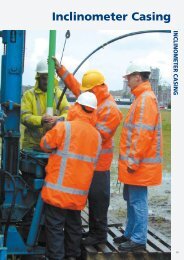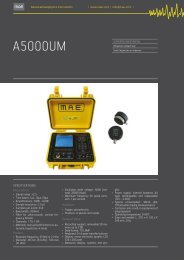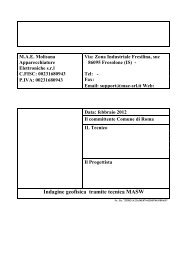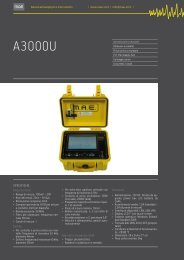Untitled
Untitled
Untitled
Create successful ePaper yourself
Turn your PDF publications into a flip-book with our unique Google optimized e-Paper software.
24<br />
SEISMIC<br />
EXPLORATIONS<br />
› SEISMIC EXPLORATION OF REFRACTION TYPE<br />
The seismic exploration of refraction<br />
type is among the most diffused and<br />
used active seismic methods. This<br />
type of survey has the purpose to determine<br />
the thickness of the overburdens<br />
(aerated) above a rigid sub-layer<br />
and reconstruct a seismic stratigraphic<br />
sequence in terms of apparent longitudinal<br />
speed. If carried out according<br />
to more sophisticated calculation<br />
methods, it can be used to intercept,<br />
measure and characterize geo-structural<br />
profiles. Seismic exploration of<br />
refraction type is carried out by placing<br />
equidistant geophones in line on<br />
the ground, and generating seismic<br />
pulses through mechanical “inputs”.<br />
Then the travelling times of the pulses<br />
that once penetrated in the ground<br />
are refracted nearby the lithological<br />
passages at different density, will be<br />
measured.<br />
› SEISMIC EXPLORATION OF REFLECTION TYPE<br />
The seismic exploration of reflection<br />
type, which is extensively used in oil<br />
explorations, is also used nowadays<br />
to obtain detailed information on surface<br />
soils. Due to the high resolution<br />
of the survey, it is used to define the<br />
development of geological structures<br />
in the sub-soil, defining the shapes,<br />
sizes and positions. The prospecting<br />
is carried out by placing high frequency<br />
geophones in line and close to each<br />
other, sending seismic pulses through<br />
energy (also at high frequency) and<br />
by measuring the travelling times of<br />
the waves that, once penetrated in<br />
the ground, are reflected by the uneven<br />
surfaces that delimit the lithological<br />
passages with net impedance<br />
contrast.









